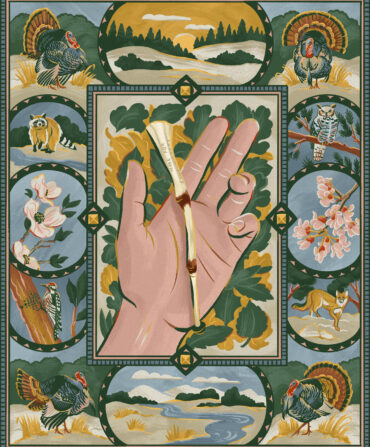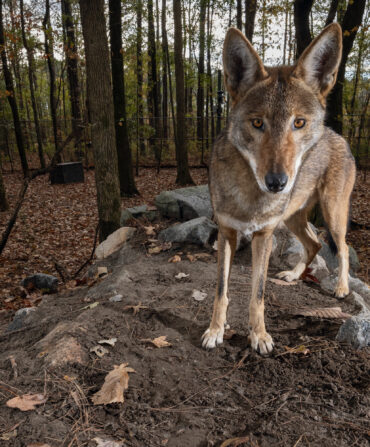Sporting
Angling for Trout in Slovenia
Amid ancient castles and craggy peaks, an intrepid group of anglers heads to the country’s Alpine streams for a trout-fishing adventure of a lifetime, steeped in old-world luxury
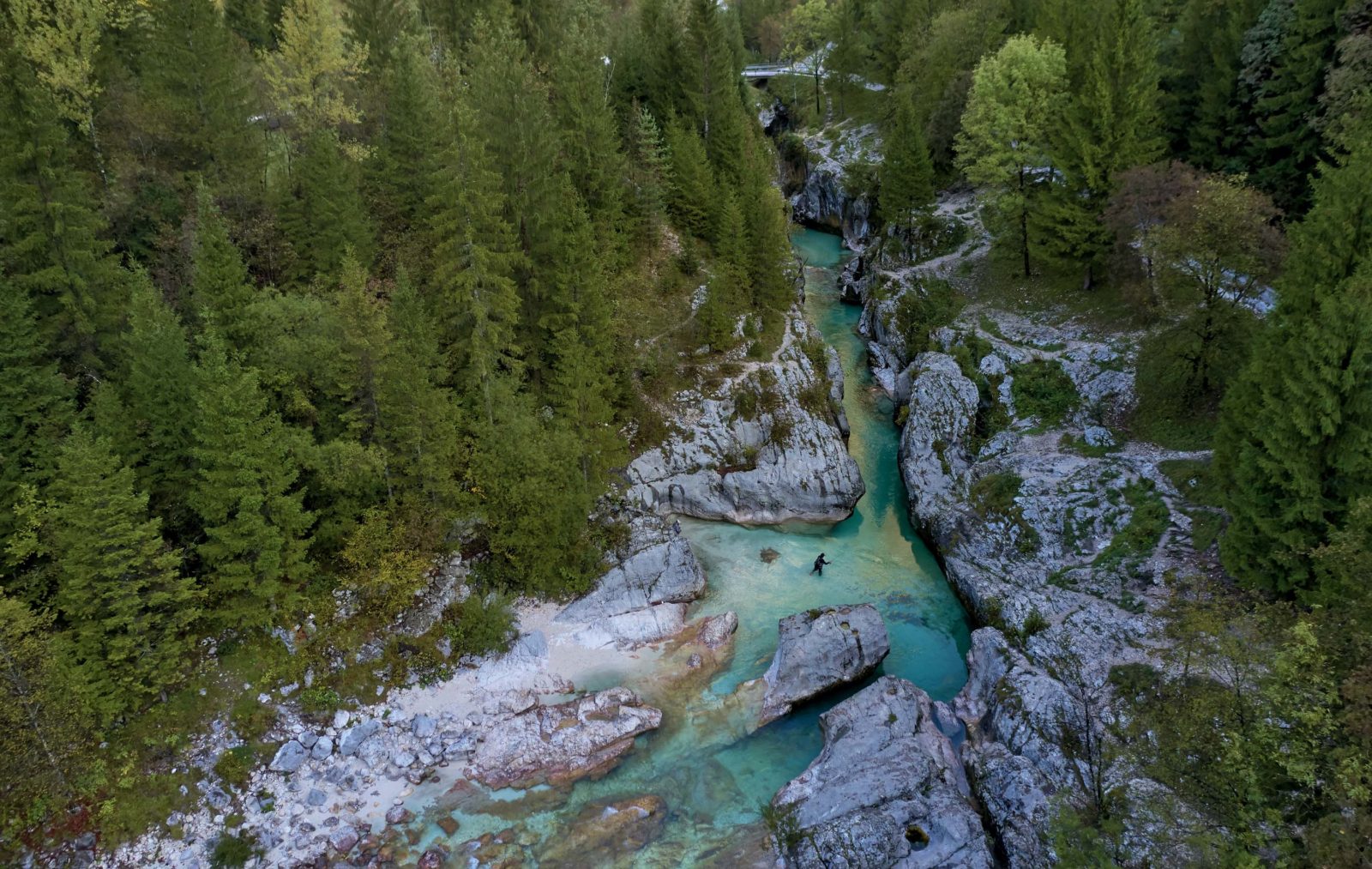
Photo: William Hereford
An angler works the water in the Soča River Gorge.
“So, do you want to fish your way, or do you want to catch fish my way?” asked my young guide, Lesly Janssen, as we drove up the Soča River valley to the river’s topmost beat on our first morning together.
I allowed as how, short of dynamiting them, I was happy to catch fish in whatever way worked best, no matter whose it was.
“Good,” said Lesly, with the relieved smile common to guides everywhere when they realize they have a pliant client in tow. “I call it ‘high-sticking a dry fly.’ It may be something you haven’t seen before.”
And it was—a totally new trick for an old trout dog. And like old dogs of every stripe, I was a slow learner.
What I hoped for on this day was to catch a marble trout—a rare, shy, gorgeously marked salmonid found in only a handful of drainages of the Adriatic basin in Central and Eastern Europe, and a fish I had never seen, let alone caught. The Soča (pronounced “socha”) River and its tributaries hold the world’s largest population of genetically pure marble trout. They also hold grayling and rainbow trout, and it was on one of the latter that Lesly introduced me to his dry fly technique.
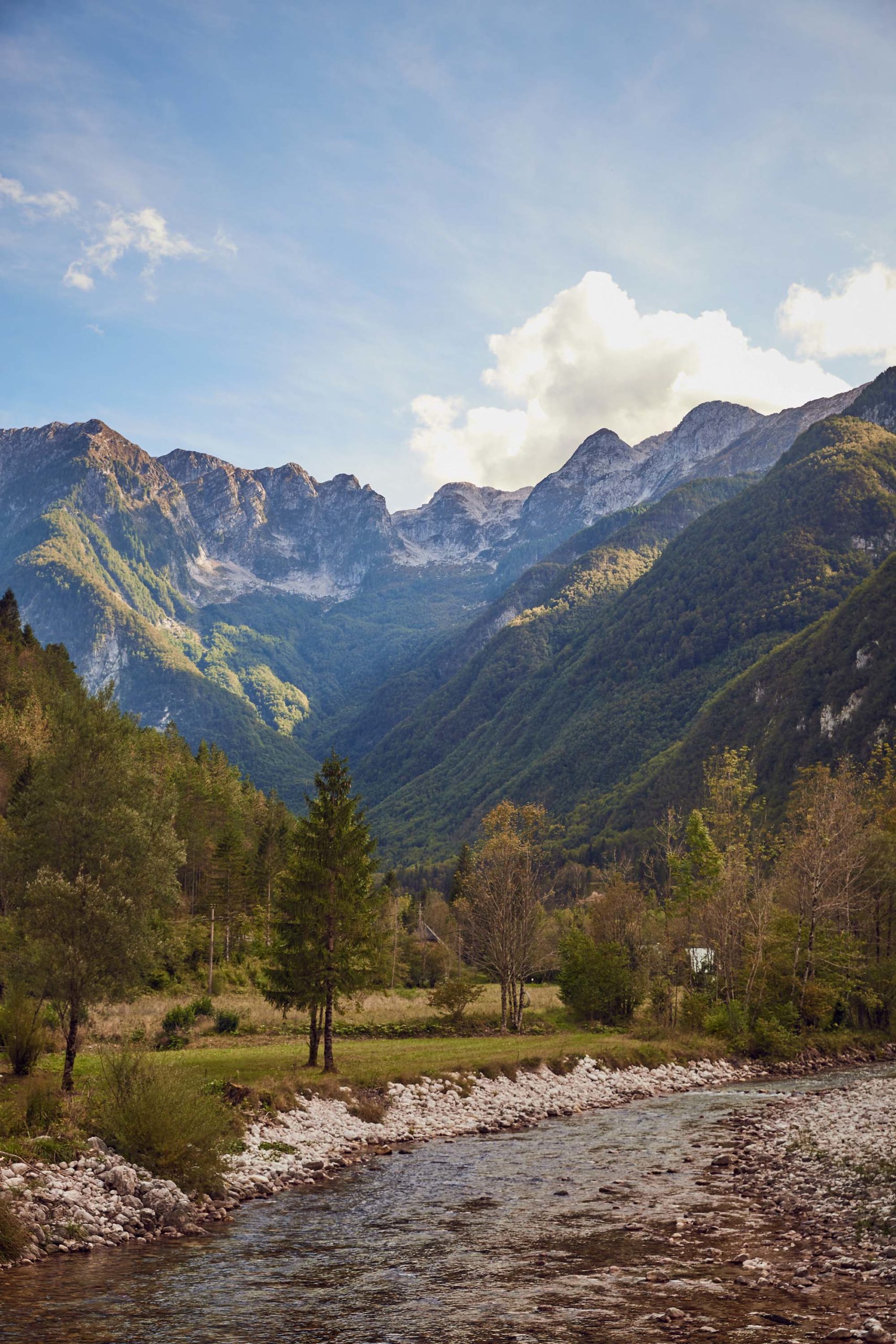
Photo: William Hereford
The Soča River holds large numbers of rainbows, grayling, and the much-prized marble trout.
We had followed a whisper of a path upstream along the river, walking slowly and looking for trout in a series of small, clear pools, and we found the first one no more than fifty yards from where Lesly had parked. As we watched the pale eighteen-to-nineteen-inch rainbow finning in a pool barely large enough to hold it and less than ten feet from where we stood on the bank, Lesly said, “This high up on the river we are fishing these little pockets, with no room for a proper drift. So, I want you to make a short, firm stroke, just a pop between twelve and ten, forefinger on the cork, so that your fly drops before the leader and no more than eight inches in front of the fish. Then use a high rod to float the fly to him with no tippet on the water and no drag.”
“Uh…right,” I said, handing him my fly rod. “Why don’t you show me?”
He did and caught the rainbow. It looked easy, but it was not. As we continued upstream, swapping the rod back and forth, I would blow a fish and Lesly would catch one. I would blow one… Then it happened to be my turn on the first marble trout we found. It was holding in an eddy, facing downstream, so we circled around in the trees to get behind it and studied it as it gobbled nymphs, its gills flaring on each take.
“It’s a small one, about twenty-four or twenty-five inches,” Lesly said, of the fish that can grow to four feet and more than thirty pounds in the Soča. “They are much spookier than the rainbows, so you will have only one shot. Drop the fly with no tippet on the water this time, just between that big rock and the trout’s nose.”
I finally managed to get it right and caught the fish, then studied it for a minute or two as it lay submerged in Lesly’s net. Its flanks were a milky gray-green scrolled with cream marbling reminiscent of Japanese calligraphy. With the possible exception of a male brook trout in fall spawning colors, it was the most exquisite trout I had ever seen.
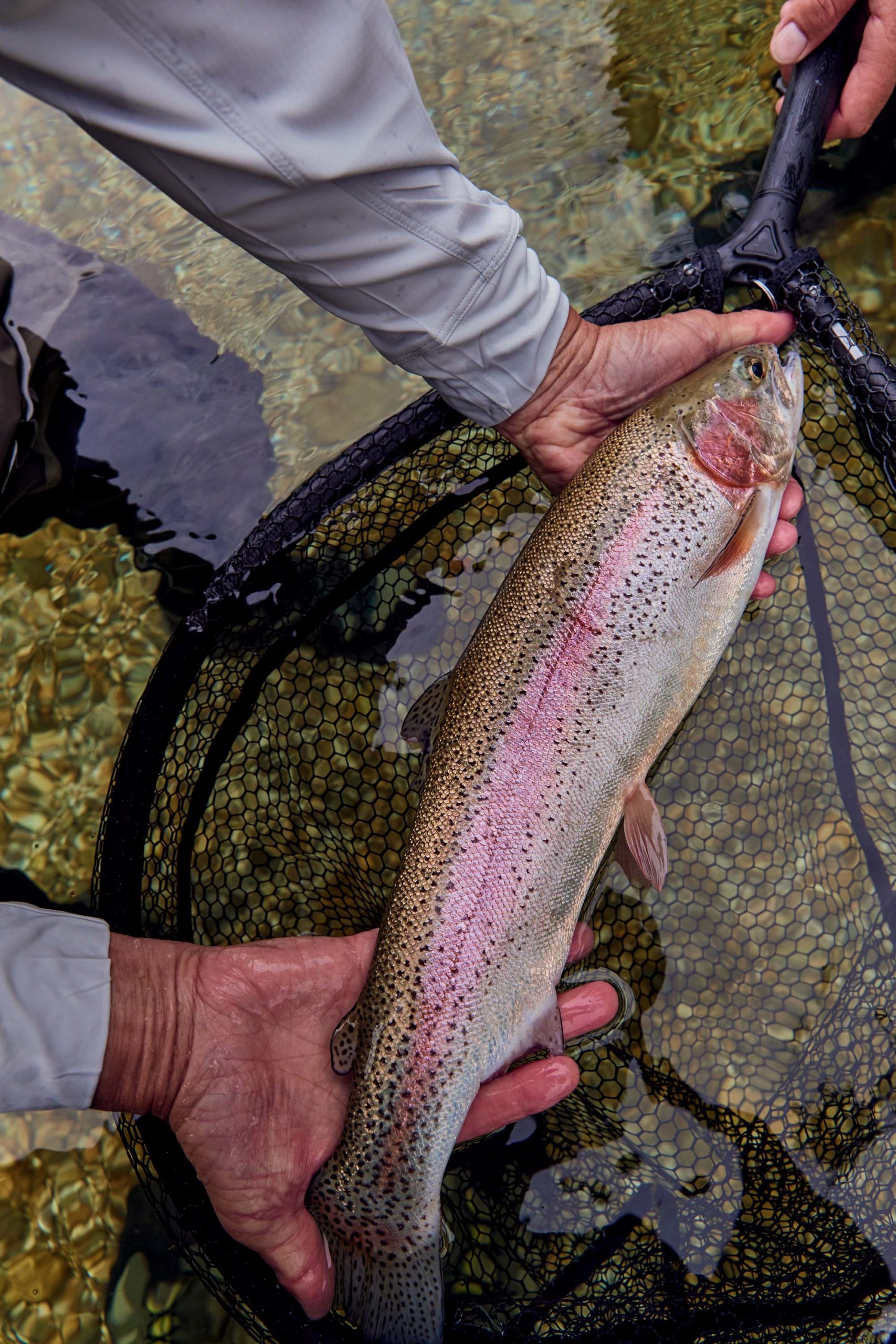
Photo: William Hereford
A big rainbow comes to the net in the Soča before release.
For the rest of that superlative day, Lesly and I swapped out on fish on the upper Soča, and later on one of its lower beats where the river was much wider, gliding heavily in breathtaking gradients of color, determined by depth, from turquoise to aquamarine to emerald to the verdigris of oxidized copper. Three-quarters of the trout and grayling we caught were on small dry caddis flies—high-sticked. At the end of the day I thanked Lesly for introducing me to the technique, to his ravishing home river, and to marble trout—none of which were like anything I had ever seen before in a lifetime of trout fishing. And that night at dinner with twelve fellow travelers I thanked, then toasted with a glass full of good local wine, my buddy Richard French for introducing our group to something else unlike anything we had seen before: the magical little country of Slovenia.
I happen to enjoy putting together hearty, convivial groups of friends, men and women, to travel around the world to fish, but also to learn about the cultures in which we find ourselves, to sample (often to excess) the best of local foods and spirits, and to lodge in memorable places. Having once been in the business of fashioning and selling such trips, I know how much work and attention to detail go into making them come off without hitches, and for the past decade or so I have left that work to Richard French, whose Toronto-based company, Slipstream Angling, does it pretty much flawlessly. For twenty-one years, Slipstream has sent anglers to more than 140 destinations in thirty-five countries. Until I came along, those jaunts were solely fishing trips, and I am certain Richard has cursed me many times for introducing another, vastly complicating element to them.
“Some of the people who travel with me, including my wife, don’t fish,” I told him the first time we talked. “Can you organize a good alternative itinerary for them with their own guide and transportation?”
“No problem,” Richard said. Since then, our group (self-designated “the A-Team”) has traveled on bespoke Slipstream trips to Cuba, Spain (twice), and Ireland. Each of those trips was so refreshingly new, so hitchlessly organized, that were Richard to recommend a bonefish trip to Lapland, the A-Team would no doubt sign up.
“Slovenia? Really? Slovenia has good trout fishing? I don’t even know where it is,” I said when Richard pitched this trip.
“Trust me, Chuck,” he said. And that was all I needed to hear.
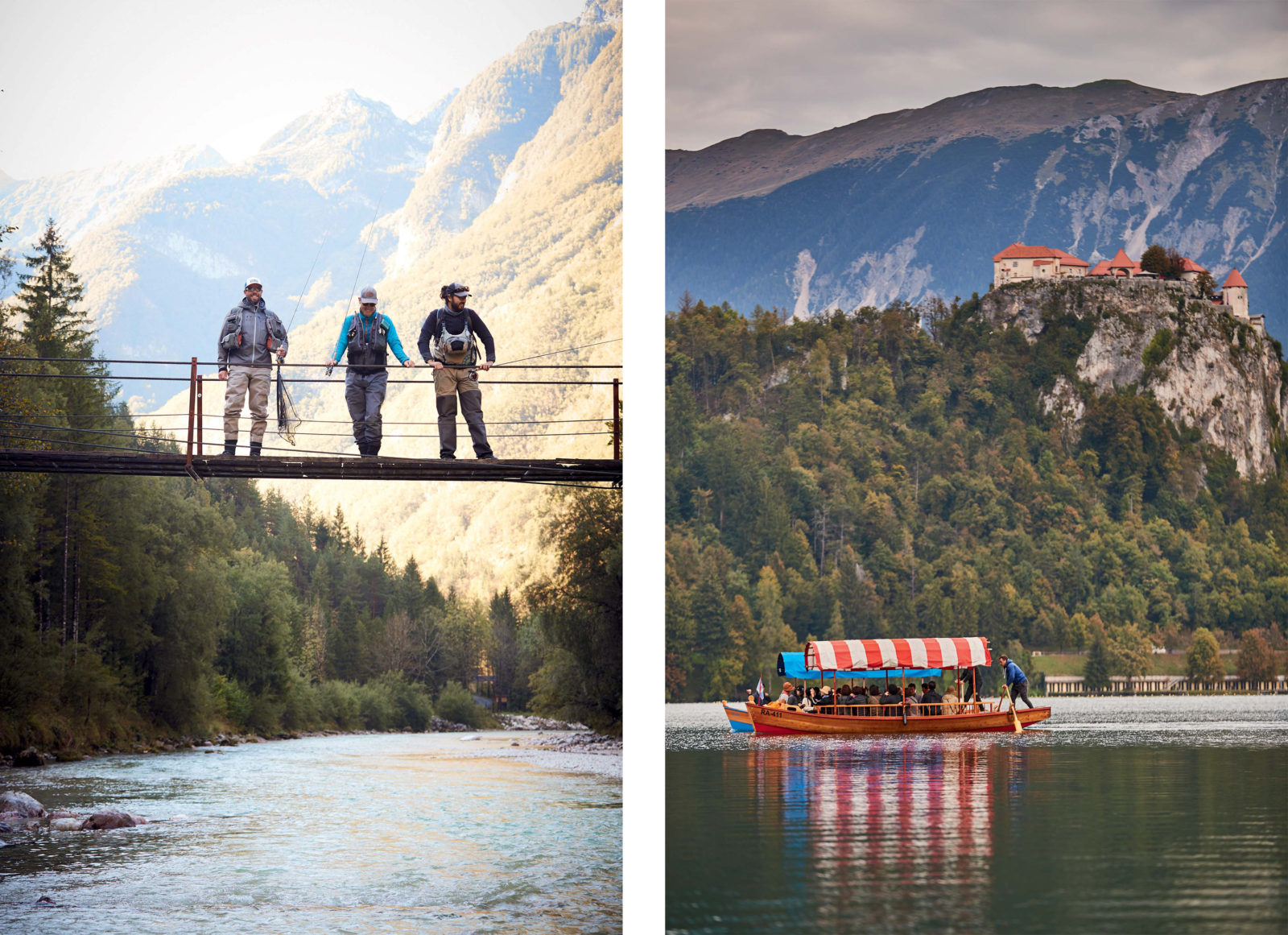
Photo: William Hereford
Anglers and guides get a bird’s-eye view of the fish from a footbridge; a pletna plies Lake Bled as Bled Castle rises in the background.
In the event you are as unfamiliar with Slovenia as I was, here are a few facts to get you in the game. With a population of just over two million, it is bordered by Italy to the west, Austria to the north, Hungary to the northeast, Croatia to the southeast, and the Adriatic Sea to the southwest. In 1991 it became one of the first republics to split from what was then Yugoslavia and become a sovereign state. It is one of the most biologically diverse and water-rich countries in Europe, heavily veined with karst underground waterways and aboveground rivers, streams, and limestone spring creeks. More than half of its nearly eight thousand square miles of territory is covered by forests that support healthy populations of ibex, chamois, red and roe deer, boars, European wildcats, lynx, wolves, jackals, brown bears…and edible dormice.
Because Slovenia has chosen to live lightly with its wealth of natural resources, National Geographic Traveler recently named it the country with the world’s most sustainable tourism. Since civilization there dates back to the Roman, Byzantine, and Holy Roman Empires, there is much in the way of ancient castles, cathedrals, and museums, not to mention spectacular scenery, to occupy all types of tourism, as our nonanglers learned to their delight. But active outdoor pursuits have made Slovenia one of Europe’s most popular tourist destinations, and nowhere are those pursuits better pursued than in the northwestern quadrant of the country near the town of Kobarid, where we began our trip.
A three-hour drive from Venice (the finest gateway city to a fishing trip I know of), Kobarid sits hard by the Soča River, surrounded by the steep peaks of the Julian Alps, on the western edge of the 207,000-plus-acre Triglav National Park, from which spring the Soča’s headwaters. The site of some of the bloodiest battles of World War I between Italy and Austria along the Isonzo Front, commemorated by Ernest Hemingway in A Farewell to Arms, Kobarid is now a sedate, postcard Alpine village of small shops, outdoor adventure companies, and sidewalk coffee shops. Its permanent population of around one thousand swells in the summer and fall to Chamonix proportions with a horde of fit, Lycra-clad, van-dwelling, backpacking pan-European hikers, mountain bikers, rafters and kayakers, mountaineers, hang gliders, paragliders, and rock climbers.
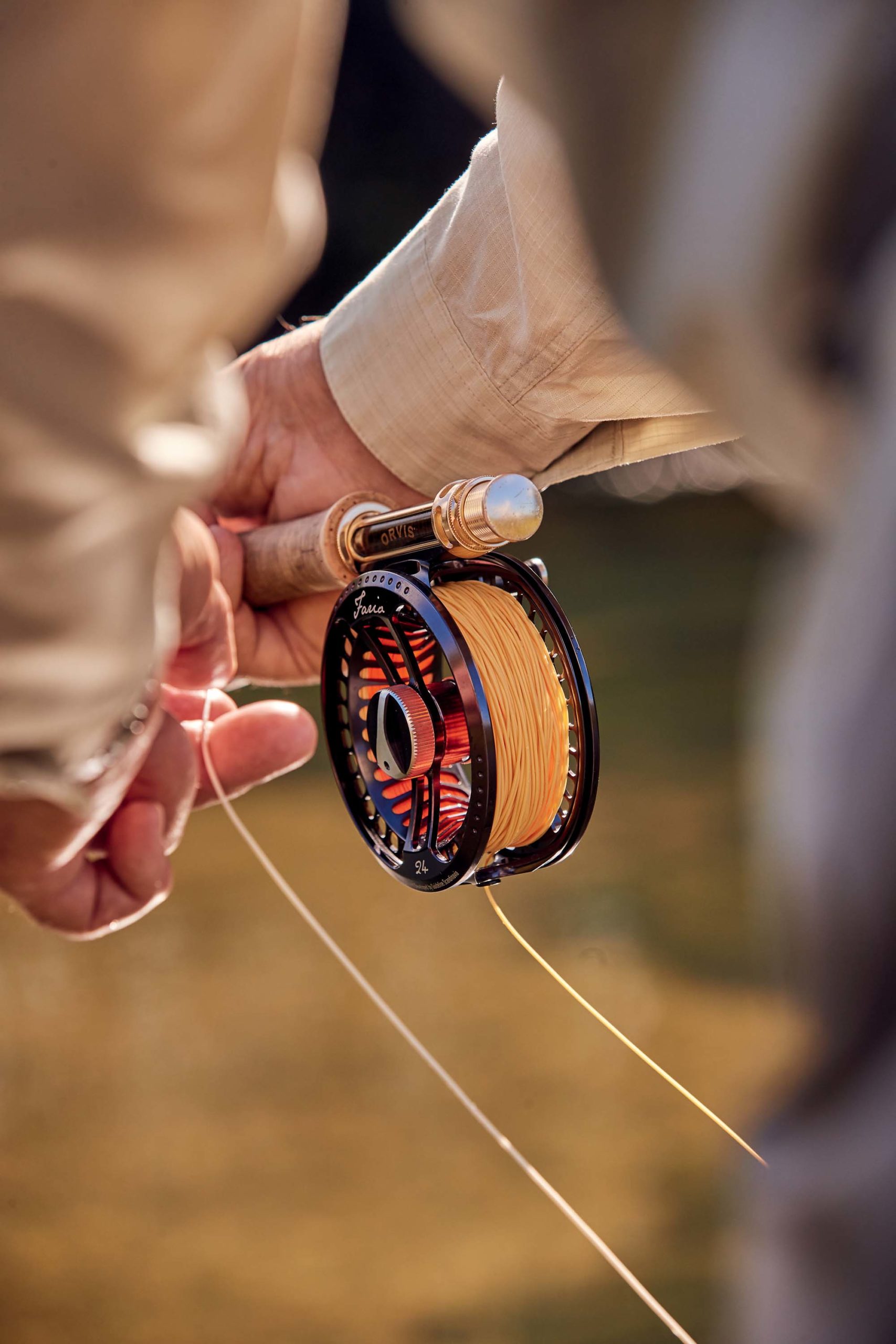
Photo: William Hereford
Working a streamer for big trout.
For our four-night stay in Kobarid, the A-Team lodged most comfortably at the Hotel Hvala on the town square, and dined very well indeed at the hotel’s restaurant, and one night—over four hours and nineteen small courses—at Hiša Franko, a nearby Michelin two-star eatery that has been called one of the world’s fifty best restaurants. Over three perfect September days, the nonfishermen toured and hiked in the national park, visited museums and cathedrals, and spent a day in the capital city of Ljubljana. And the anglers…well, we angled.
Known as the “Green Pearl of the Alps,” the Soča and its tributaries provide more than ninety miles of extremely well managed (by local fishing clubs) trout fishing, as diverse and technically interesting as you can find anywhere. From the plunging cascades and frothy pools in the rocky canyons of the upper Soča to the wide, preternaturally turquoise blue glides of the lower beats, the river accommodates pretty much all skill levels and techniques. Over three days of fishing, our anglers, of widely disparate trout fishing experience, caught rainbows, grayling, and marble trout up to twenty-eight inches using dry flies, nymphs, streamers, and terrestrials.
On our last day there, my friend Ellen Jackson and I started off blind casting Woolly Buggers for fat rainbows on the lower Soča, then spent the afternoon on the hypertechnical trophy beat of a Soča tributary, the Idrijca, tossing size 22 blue-winged olives on fifteen-foot leaders tapered to 7X in slow, complex, tannin-stained currents for rising brown and marble trout—many of them large and all of them discriminating.
So agreeable was everything about Kobarid and the fishing in the Soča River valley that when we left them, with four nights and three days remaining on our trip, I was concerned that perhaps we had peaked too early. I had nothing to worry about.
On the eastern side of Triglav National Park, a two-and-a-half-hour drive from Kobarid, the town of Bled is Slovenia’s premier Alpine resort destination and one of the most enchantingly sited towns in all of Europe, tucked as it is around the eastern end of Lake Bled and hulked over to the north, east, and west by the snow-topped Julian Alps. The lake is nearly four miles around, almost a hundred feet deep, and a saturated cobalt blue. Near the middle of it—the first photograph everyone takes in Bled—is a rocky islet entirely occupied by a graceful, tall-steepled seventeenth-century church. Across from the island, on the lake’s north shore, a castle, part of it dating from the eleventh century, sits atop a sheer three-hundred-foot stone cliff rearing operatically above the water—that’s the second photograph everyone takes.
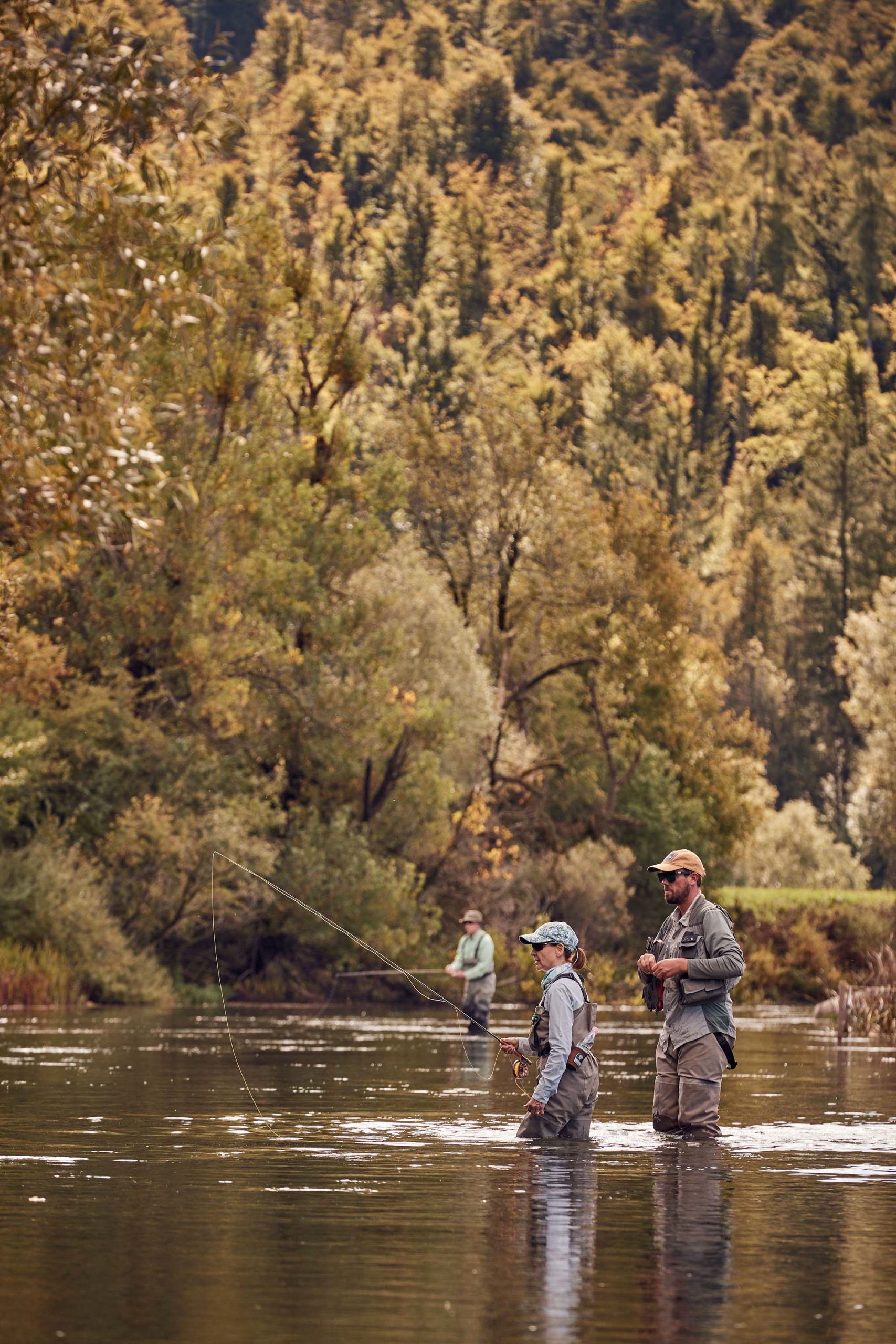
Photo: William Hereford
Anglers and their guide on the Unica.
Ducks and swans ply the lake, as do racing sculls and lovely twenty-two-foot flat-bottomed, striped-canvas-topped passenger boats called pletnas, which are rowed by one person standing in the stern and have transported tourists to and from the islet since the 1600s. No motorboats are allowed on Lake Bled, and its perpetual calm, sheltered from almost any wind by the surrounding peaks, has much to do with the fairy-tale charm of the town and its setting. Each evening from the balcony of our room at the Grand Hotel Toplice, my wife and I watched, spellbound, as the setting sun drenched the castle in a spill of gory orange, like a medieval raining down of boiling oil. And on my dawn walk each day along the lakeside promenade, the wide-angle cameras held by throngs of early-rising tourists—all pointed at the islet church and the snowfields on the mountains above it—clicked as incessantly as the hum of cicadas.
The moment I laid eyes on the place, with a feeling of having stepped into a dream, I knew I could not leave Bled without seeing something of it and its fetching countryside without a rod in my hand. So on our first full day there, I took rare leave of my fellow anglers and joined up with the others, their guide Luka Resman, and photographer William Hereford for a day of touring.

Photo: William Hereford
From left: Loaded for trout—and good times; Enjoying lunch and fish tales after a morning on the Unica.
We were ferried by pletna to the islet, crossing the lake in a satiny mist; above us, the dowager faces of ornate nineteenth-century villas peered down through breaks in the woods surrounding the lake. We climbed the ninety-nine steps up to the Church of the Mother of God on the Lake, marveled at its gilded altarpiece, and rang the steeple bell three times for good luck as tourists have done for centuries. Later we toured the castle; took a riverside hike through the spectacular Vintgar Gorge; lunched late at a hunter’s restaurant, deep in the woods, which featured on its menu roasted bear paw, wild boar medallions, and chamois soup; and finished off the day at the small country Church of St. John the Baptist, internationally famous for the thirteenth- to seventeenth-century frescoes that grace every inch of its walls and domed ceiling.
Wrapped in mist and drizzle, the entire day had the feeling of an earlier, more stately Europe, a sort of Edith Wharton resonance that was only reinforced by the hotel we returned to that evening. With its mauve drawing rooms, its tuxedoed bellmen and waiters, its large guest rooms furnished with antiques and Oriental rugs, its snug bar and vast sitting area with floor-to-ceiling windows overlooking the lake and Bled Castle, its private beach and thermal-water spa, the old-world hush of its carpeted corridors on whose walls hang photographs of Prince Charles, the king of Spain, and other European royalty who have vacationed here, the Grand Hotel Toplice makes you want to enter its formal dining room for dinner wearing spats and carrying a calfskin-bound volume of Proust.

Photo: William Hereford
The Church of the Mother of God on the Lake stands tall in the morning light.
Not having gotten that memo, the members of the A-Team we met that night were wearing Patagonia and large smiles, and carrying nothing, it seemed, but stories of the great fishing I had missed. As does Kobarid on the other side of the park, Bled offers up a movable feast of trouting opportunities in more than a dozen rivers within an hour’s drive from the town. The largest and most productive of those is the Sava Bohinjka, a classic Alpine river that runs for nineteen miles through glaciated gorges and meadows rich with insect life, and holds, along with its tributaries, large populations of rainbows, grayling, and a few brown trout. As at Kobarid, the fishing out of Bled is managed by fishing clubs that charge a daily fee (usually between $75 and $100) and assign anglers to daily beats in order to equalize fishing pressure on the rivers. Again as at Kobarid, the system worked very well for our group on the Sava, since we rarely fished in sight of other anglers and the fishing we had there ranged from very good to the eighty-plus-fish day my trout-crazed friend C. T. Fitzpatrick had in one of the river’s gorges.
The rainbows in the Sava can grow upwards of thirty inches, and a healthy percentage of them go over twenty, which makes the decision to fish anywhere else while you are in Bled a difficult one. But Richard French and I prefer spring creeks to all other venues of trout angling, and on the next day our guide, Gregor Štepec, took us to one that is now among my favorite spring creeks anywhere.
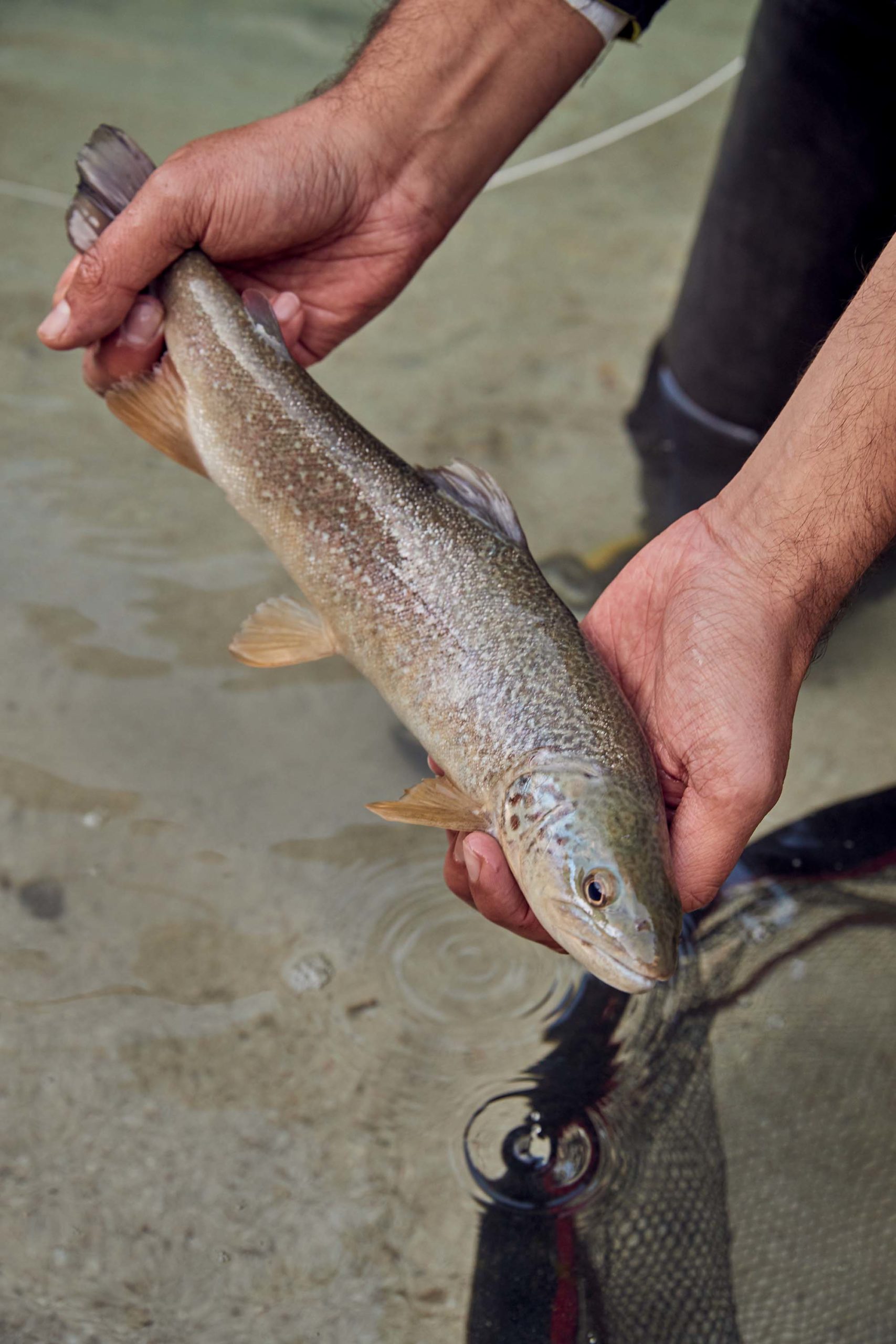
Photo: William Hereford
A small marble trout.
An hour’s drive southwest of Bled, the Unica meanders in a quintessential chalk-stream stroll for ten miles through meadows and copses of trees, varying in width from twenty to forty feet, and in color from olive to strong tea. Six anglers from our group were spread out along the Unica that day and, fishing slowly and singly, we rarely saw one another. The countryside was as tranquil and comely as a Courbet landscape. The currents and lies of the creek required study—best done, like the casting, camouflaged from the bank—and the patience to spend a half hour or more fishing fifty feet of water. Like spring creek fish everywhere, the brown trout and grayling in the Unica were shy and finicky, and sometimes too big for the very fine tippets necessary to fool them into eating our size 24 blue-winged olive imitations.
The defining fishing moment of the trip for me, now a lifelong lodger in my memory, was finally hooking—after a dozen or more refused casts to its difficult lie behind a rock and beneath a branch—a grayling close to two feet long, playing it for three or four minutes as delicately as I could, then watching it run back behind its rock, roll, and break off. I felt like applauding the fish!
A beautiful, life-loving woman and a good and spunky angler, my pal Melanie Grinney has a knack for summing things up. In a fly shop outside of Bled where she and her husband, Jay, were buying their fishing permits early on the morning of our second day there, the proprietor, a jolly, bearded wine keg of a man, insisted that they could not leave without sharing a “de-stressing” glass of his homemade blueberry schnapps, never mind the hour. Pulling from beneath the counter a bottle and glasses for Melanie, Jay, their guide, and himself, he placed them ceremonially on a glass case holding hundreds of beautifully tied Slovenian nymphs, filled the glasses two or three times, and started everyone’s day off with a stressless buzz.
“Soul,” said Melanie, telling us about it at dinner that night. “This Slovenian trout fishing is all about soul!”
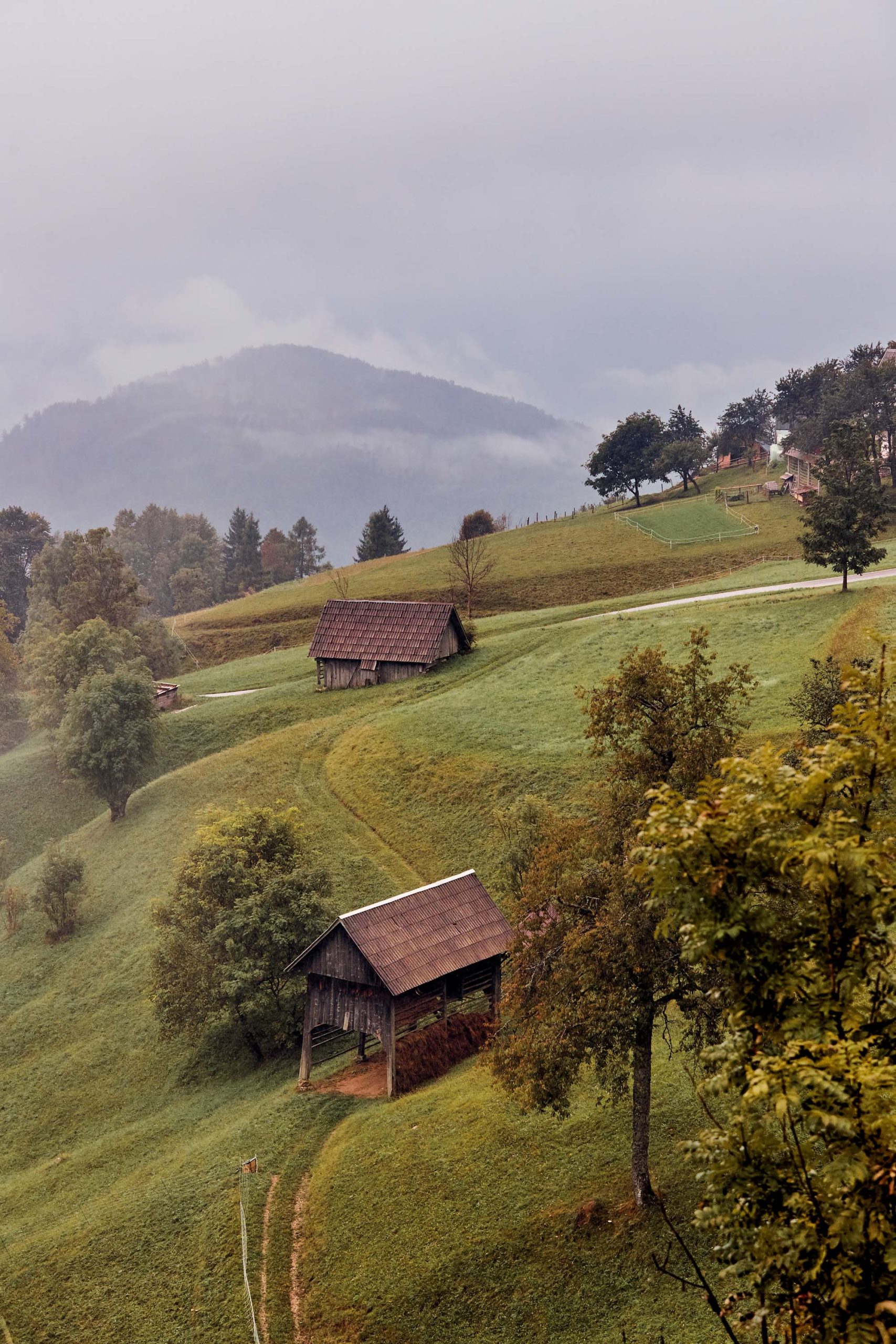
A country vista outside of Bled.



